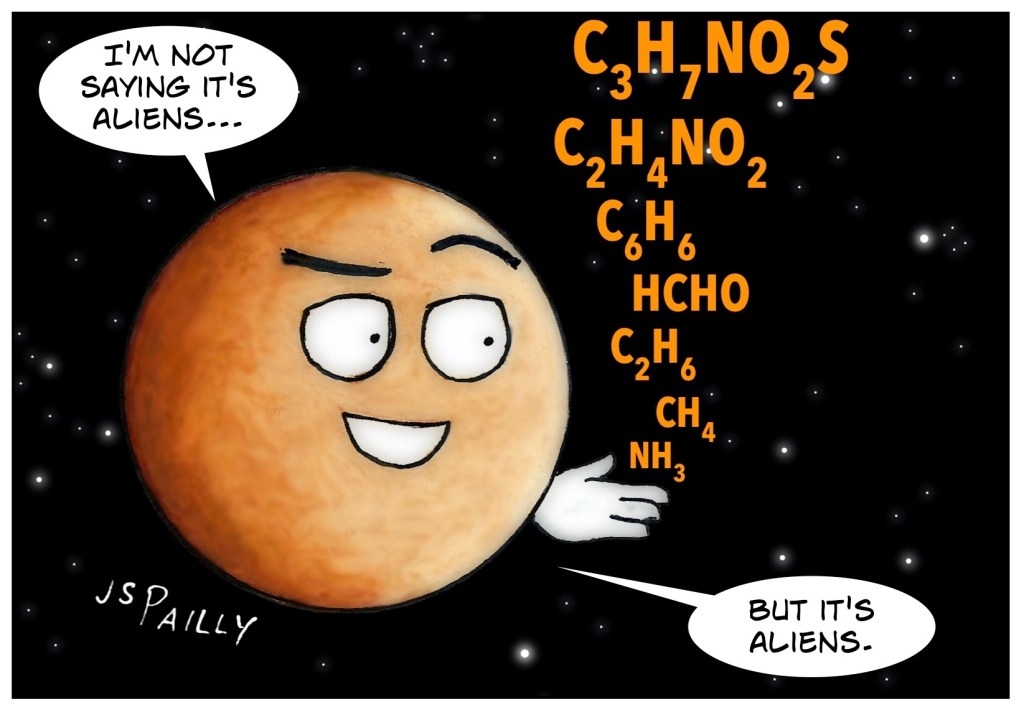Hello, friends!
So I recently found this 100% totally legit JWST image of Venus, revealing some of the weird and scary chemistry that happens in Venus’s atmosphere. As you can see, Venus sure does love chemicals. Super noxious, super toxic chemicals. With all those noxious and toxic chemicals in her atmosphere, you’d think Venus must be a pretty unlikely place to find life.
Now add in a runaway greenhouse effect that makes the surface of Venus hotter than the daytime surface of Mercury. Now add in atmospheric pressure that rivals the deepest, most-submarine-crushing depths of Earth’s oceans. Now add in some sort of volcanic activity (the specifics of which remain mysterious) that seems to sporadically spread fresh lava over nearly the entire planet’s surface.
So yes, Venus is an unlikely place to find life. Venus is among the least likely places in the whole Solar System to find life. And yet, the possibility of life on Venus does come up in the scientific literature from time to time. So how would that work? How could living things survive on a planet so infamously hostile to life?
Have you ever heard the expression “sink or swim”? Well, if any sort of life exists on Venus today, its motto must be “fly or die.” Everything about Venus is dangerous and deadly, but the most dangerous and deadly conditions are found at the planet’s surface. So if you’re a Venusian life form, don’t go to the surface. Stay aloft in the atmosphere. At an altitude of about 55 kilometers up, you should be safe safe-ish. The global lava floods (however frequently or infrequently that happens) will be far below you. The extreme pressure and temperature will be far below you as well. You’ll still have to deal with all those scary chemicals in the atmosphere, but if you’re clever (or rather, if evolution is clever for you) some of those scary chemicals might be usable to you as nutrients.
If the idea of perpetually airborne life—of life that never, ever touches the ground—seems farfetched, then I need to tell you that microorganisms can and do live in the upper reaches of Earth’s atmosphere. That’s not an ideal environment for them. They’d much rather be down on the ground, where water and nutrients are more plentiful. But microbes can survive way up there, if they have to. Earth has a whole “aero-biosphere” of airborne microbes that scientists are only just beginning to understand.
And if Earth has an aero-biosphere, then maybe (maybe!) Venus could have some sort of aero-biosphere, too. It may not be likely, but it’s not totally impossible.
WANT TO LEARN MORE?
Here’s a link to diagram, originally from a paper on the possible habitability of Venus, showing what the life cycle of Venusian airborne microbes might be like.
And here’s a short press release from the Johns Hopkins Applied Physics Laboratory (A.P.L.) describing the so-called “Venus Life Equation,” which is sort of like the Drake Equation for life in the universe, but for just Venus.
And lastly, regarding the mystery surrounding Venus’s volcanic activity, we know Venus’s surface got “paved over” by fresh lava at some point in the recent past, but we don’t know how frequently this sort of thing happens. It definitely happened at least one time. Maybe it’s happened more often than that, or maybe it’s a continuing process that’s still happening today. Here’s an article from the Planetary Society explaining why the global resurfacing of Venus remains such a big scientific mystery.
P.S.: Okay, I lied. The image I used at the top of this blog post? That’s not really from JWST. Actually, I’m pretty sure JWST cannot safely observe Venus, due to Venus’s proximity to the Sun. I drew that image myself. And if you like my drawing of Venus, and if you want to do something to support what I do here on Planet Pailly, please consider visiting the Planet Pailly store on RedBubble. There, you can buy my “Venus ‘Hearts’ Chemicals” drawing (and other drawings I’ve done) on a T-shirt, pillow case, spiral-bound notebook… personally, I think today’s drawing would look great on a little notebook, maybe for chemistry class!













